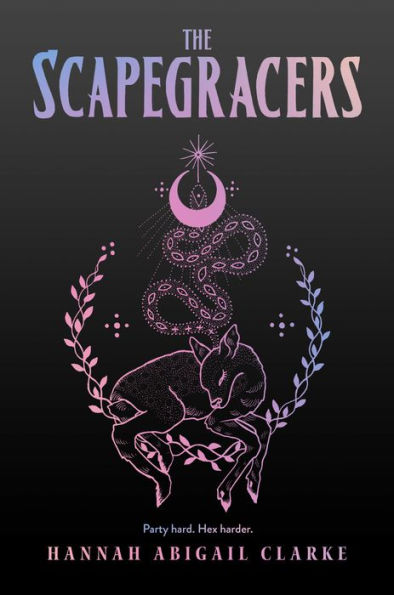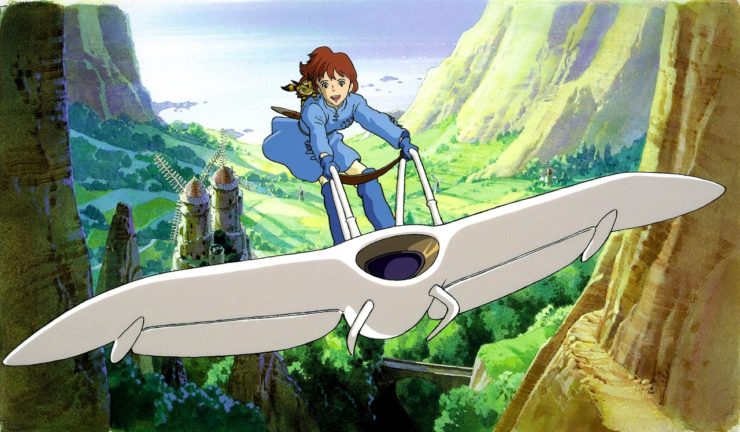In this period of prolonged enclosure, I have been thinking about hope and apocalyptic bugs. While the calendar’s been melting, I’ve been crawling into childhood movies to pass the time, particularly the pre-Ghibli Hayao Miyazaki 1984 film, Nausicaä of the Valley of the Wind.
In this titular equation, Nausicaä is a princess, and the Valley of the Wind is her close-knit kingdom in some far future post-catastrophe tech-enabled feudal world. The distant catastrophe resulted from a week of mankind’s military obliteration of Earth by giants, which I’m inclined to conceptualize as nuclear fallout, and the resulting devastation created a bug-filled toxic jungle perpetually encroaching upon our human survivor settlements. Disney dubbed the film in 2005, which means that upon its release, I was a weird little eight-year-old—young enough that I incorporated story motifs into my narratological DNA without any impulse toward the critical or analytic, and old enough that I could follow the relatively violent plot. I watched it incessantly and then not at all for upwards of a decade. Then, the other day when I desperately needed literally anything to do, I saw it again.
Nausicaä’s world is hopeful, but that hope is bracketed by compoundingly bleak circumstance. All humans live in direct proximity to the toxic jungle, a tangle of creamy fuzz that is home to mega fucking enormous bugs, just absolute Cambrian monstrosities of stringy legs, gnashing teeth, and fun parasitic body segments, and aggressively poisonous spores. Once the spores encroach upon wholesome flora, that flora becomes contaminated and must be burned. People wear masks in this movie. They do not eradicate the jungle. They do not cure the existential threat of irrevocable bug-and-toxins based climate catastrophe at the end. The first line of dialogue is, “Yet another village is dead,” and the pattern is likely to replicate itself all across the globe. A war nearly breaks out, then does break out, between neighboring human kingdoms. People give imperialism a go. People burn their own cities down to avoid imperialism. People burn their own forests down to prevent spores from spreading. People attempt to resurrect a humanoid not-bomb to breathe atomic fire over the bugs and their jungle, and this only stirs the bugs into a frenzy. Militarized violence against the backdrop of post-industrial climate catastrophe is crushingly hopeless in a way I recognize. I’ve heard people deem nearly all the pre-, mid-, and post-apocalyptic SF I’ve grown up reading and watching prescient for our current circumstance. I’d certainly include Nausicaä’s many-layered calamity among them.
But lo! The above mentioned hope comes in prophecy form. This prophecy is given to us in a stand-out domestic scene, wherein Nausicaä, uncharacteristically dressed in full femme cultural gear, lays on the floor next to a cooking relative whom I assume is her grandmother while her uncle and father discuss politics above them. Nausicaä is substantially more subdued in this scene than she is in much of the movie, only jumping in to question why her uncle can’t settle down in the valley with them. We are then told by her grandmother that her uncle is seeking prophecied absolution from this strife, though this seems to be news to Nausicaä’s uncle himself. Exposition grandma references the mounted tapestry beside them and says, “After a thousand years of darkness he will come clad in blue and surrounded by fields of gold to restore mankind’s connection with the earth that was destroyed.”
At least according to the folk-tradition-via-weaving interpretation of our promised savior, the man in blue is an adult with well-groomed facial hair.
Here’s the thing: it’s Nausicaä. Nausicaä in a red dress stained blue with bug blood, lofted above the earth by endless golden bug tentacles.
What I’m proposing here is that Nausicaä of the Valley of the Wind is hopepunk, and that its hard-earned, difficult to swallow hope lies in the raw potential of compassion, research, cooperation, and a cosmic sort of transness. By and large, I am concerned with the third and forth prongs of this. When I say a cosmic (or perhaps narrative) sort of transness, I don’t mean to suggest that Nausicaä herself is textually trans, per se—issues of transition, or even naming gender, don’t come into the plot’s fold. I would argue that there is a certain nonconforming verve to Nausicaä, in that her culture seems to favor head coverings and long skirts for women, and Nausicaä eschews both her daily life, but this fact is not my focus here. What I’m interested in is the shift in cosmic stakes and what that means about hope for this post- and pre-apocalypse, and perhaps, at least gesturally, our own.
Buy the Book


The Scapegracers
The man in blue myth, as depicted by the tapestry, is a man of legible composure and esteem. His blue tunic does not have a DIY vibe, so we can perhaps extrapolate that such a garment would be dyed blue at the time of its creation. The fields of gold are depicted in a way I can only assume is meant to suggest wheat, a visual motif that calls to mind abundance and natural plenty. The man in blue myth offers a sort of essentialist paradigm: he is a man, because he was created to be so, he wears blue that was created to be so, he is surrounded by plants that grew out of the earth and are the most literal interpretation of what a golden field is understood to be. Of course, this overcuts the cultivation that all of these categories require to be legible—the man’s facial hair is groomed and shaped to indicate something about his person, the shirt must be spun and woven and dyed, likely at great expense considering blue pigment’s history, the field must be upkept by peasantry—but cisness is good at overlooking its own ongoing self-creation in favor of seeming natural and inevitable, is it not? There is no discourse surrounding the man. There are no conversations about why the man is a man, or why the man must appear with his particular combination of costume pieces and scenery. We might simplistically lump ‘blue’ with ‘boy color,’ assume that his particular array of props and materials are naturalized, essential parts of his masc heroism. When exposition grandma tells us about the man, Nausicaä can finish her sentence. Even though she’d had trouble identifying the man in blue myth a moment before, the story is so ingrained within her that she can recite it without pause. Throughout the course of the film the man in blue is rarely mentioned. There is no curiosity about him. He is a narrative inevitability, a fact of the story’s cultural landscape.
When Nausicaä is revealed to be the man in blue, there is nothing natural or inevitable about it. We’ve seen, before this climactic point, how her borrowed dress became so drenched with blood that it changed from red to blue. We know that she was given that dress by somebody else as a disguise to escape dangerous circumstances. We’ve consistently seen Nausicaä do the things that we might assume the man might do—she engages in radical nonviolence with the bugs, has researched ways of purifying the toxic plants so that they might coexist with humanity, has formed kinship bonds with the bugs the world has told her to despise—actively, and intentionally, against the social standard. The gold that surrounds her is straight up not wheat at all, but the wriggly mass cooperation of an endless sea of bugs, who all lift her with the utmost gentleness so that they might heal her together. When exposition grandma is informed of revived Nausicaä’s current aesthetics, she recites the prophecy again, retaining the he/him pronouns, and weeps that the legend is true. There is zero discussion of the seeming gender incongruence of bug blood Nausicaä and the prodigal blue guy—it is taken wholesale that she is the prophecy fulfilled, and that humanity therefore has hope despite how deeply fucked it may appear.
I am left with this: in Nausicaä of the Valley of the Wind, hope requires transition. Cosmic transness makes hope an active, collaborative process, rather than one that is passive, assured, inevitable. It is something that one inhabits and acts upon over and over again, regardless of sometimes violent discouragement, that informs one’s relationships with their community, their environment, the world around them at large. Transition is an ongoing and undulating process, one that does not always have a singular climactic peak, but in Nausicaä’s case, we might read the borrowed red into bug blood blue costume shift as a sort of thesis on hope. It cannot be waited for, and it will not manifest itself from nothing fully formed and immutable with all expectations pre-programed into its very being. Hope cannot come into the world in a cis sort of way—once felt, it must be collaboratively pursued and amplified. It requires experimentation, unconventionality, risk, kinship, perseverance. A being that can change the world is bound to be a changeable being, particularly one working in tandem with a community that recognizes that change and claims it joyously. May the changes we ourselves create be also met with such displays of solidarity. On Nausicaä’s beat, individual hope is something we can harness only by working relentlessly and tirelessly together.
Hannah Abigail Clarke is here and queer, etc. They have been previously published in Portland Review (forthcoming), PRISM International, and Chaleur. They will graduate from college at Miami University (of Ohio) come May. The Scapegracers is their first novel. (They, he, or she pronouns)










